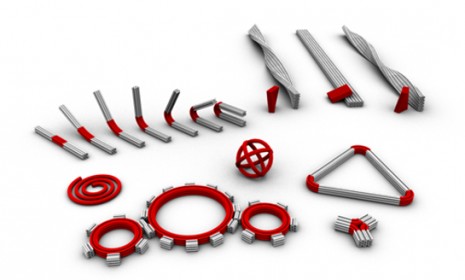The 'DNA robots' that hunt cancer cells
Harvard scientists invent a novel method of eliminating invasive tumors, employing nano-sized machines fashioned after white blood cells

In a concept that sounds eerily similar to science fiction, researchers from Harvard University have created tiny nano-sized "DNA robots" that can be instructed to hunt and destroy cancer cells. Scientists created the bio-machines to carry out the duties normally reserved for immune-system-boosting white blood cells, and the mini-robots could potentially lead to treatments for other autoimmune diseases. Here, a brief look at this "exciting" new experimental form of therapy:
How do these robots kill cancer?
The tiny devices were constructed out of DNA strands and folded into a shape resembling a clamshell. Researchers call it the "DNA origami" method. The devices are pre-programmed to open up in the presence of cancerous cells. Once open, the robot releases a series of antibodies that cause its target to self-destruct. "The idea is based on the behavior of the body's immune cells," says Elizabeth Lopatto at Bloomberg Businessweek, "which recognize viruses or other invaders and attack them." (Watch a demonstration below.)
The Week
Escape your echo chamber. Get the facts behind the news, plus analysis from multiple perspectives.

Sign up for The Week's Free Newsletters
From our morning news briefing to a weekly Good News Newsletter, get the best of The Week delivered directly to your inbox.
From our morning news briefing to a weekly Good News Newsletter, get the best of The Week delivered directly to your inbox.
And this really worked?
In preliminary lab-controlled tests, a team of Harvard scientists, led by Shawn Douglas, used the DNA robots to identify and effectively kill leukemia and lymphoma cells in a petri dish. "In diseases such as cancer, we know if we can find every single last cell and kill or reprogram it, we can cure disease," said Douglas.
What's next for the cancer-killing bots?
Researchers will test the robots in animals like mice. Introducing the robots into living bodies will present a new set of challenges, says The State Column, including figuring out how to minimize the robot's toxicity levels, and increasing the amount of time the robots can circulate in the blood stream, particularly because the DNA robots can't reproduce on their own. Commercial use of the robots is still years away.
A free daily email with the biggest news stories of the day – and the best features from TheWeek.com
Sources: Bloomberg Businessweek, Mashable, The State Column, Technorati
-
 Received a gift card this holiday season? Here’s how to maximize it.
Received a gift card this holiday season? Here’s how to maximize it.The Explainer Make the most of your present
-
 ‘Lumpy skin’ protests intensify across France as farmers fight cull
‘Lumpy skin’ protests intensify across France as farmers fight cullIN THE SPOTLIGHT A bovine outbreak coupled with ongoing governmental frustrations is causing major problems for French civil society
-
 The best books of 2025
The best books of 2025The Week Recommends A deep dive into the site of a mass shooting, a new release from the author of ‘Atonement’ and more